How do expert sales forecasting systems work or how many tablets to load in grams
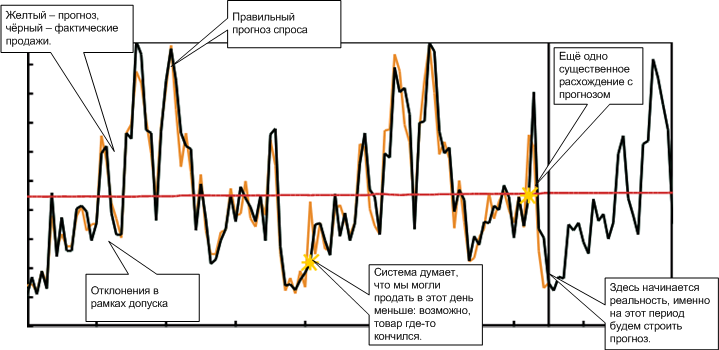
I have already written a brief overview of how IT solutions help optimize supply chains. Now I will talk about how such systems are implemented in reality in Russia and what it gives . Unfortunately, I cannot call specific customers, therefore we will now trade in abstract phones and tablets and face the same problems.
So, imagine, two years ago you decided to trade phones and even opened an online store. At first, everything was simple: orders are quite small, and everything can be counted on a piece of paper. Two months later, it became clear that the store is stable, and it is necessary to deal with supplies seriously - because if the user does not see his favorite mimic tablet with a minimum markup, he will simply buy it from another store, and you lose the chance to sell not only the tablet, but also expensive covers, adapters, and so on.
')
Accordingly, you now have three tasks:
- Maintain a range of products in the main line;
- Understand how many sales will be to plan the purchase of accessories;
- To keep on control all the hits and news to always sell marketable goods and "shoot foam" on the launches of new devices.
At this point, there are about 200 items in the assortment: it’s difficult to count everything on a piece of paper, so you start keeping an Excel where you count the speed of sales, the speed of deliveries from a distributor or manufacturer, and so on. Little by little it becomes clear what to do with hands all this is hellishly difficult, and you write a module to your accounting system (for example, to 1C), where purchases are predicted.
Thus, you solve your main task - you can receive alerts that you need to buy goods at the right moments, plus you can see the state of the warehouse after a week of normal sales.
Sadly, about 90% of domestic retail and wholesale companies are now at this stage.
If everyone lives like this - what's the problem?
Last January, you suddenly had a problem with an empty warehouse. A few dozen orders came on the day, but you could not respond to them: you just ran out of top phones and tablets. Of course, you guessed that in December sales will be much more than usual, and in January your suppliers will wake up only around the 15th day, but they didn’t appreciate how many sales there will be.
Then, in March, there was a launch of the new product: you launched a new, say, Maypud NEW, about which you only knew that it would be very hot. You figured out how many past Maypuds were sold in a month, bought a couple of dozens of new ones - and faced with the fact that the new ones were not enough, and the old ones remained in the warehouse for a couple of months, even had to arrange a share to sell them.
And by this time you already have more than 1000 items of tablets, phones and various accessories, and from a dozen different suppliers. On the day, 10 new items are added to the assortment matrix, and 2-3 products leave (on average). You have three purchasers who are constantly going crazy with the load, mowing up on non-top goods (you cannot sell a single batch of tablets from China for half a year) and often forget the shipping dates, which leads to discontinuities and customer dissatisfaction. Plus, your suppliers are not always stable: someone cuts your batch in half, someone delays delivery, someone is stuck with a whole container of your already paid products at customs, and so on. And for each situation it is necessary to make a decision.
And besides, you have a network of points of issue and stores - and in stores it also took to keep a stock of goods. Roughly speaking, with N points of sales, the task became more difficult N times - however, the price of a local error is already lower in comparison with the error in the main warehouse.
As a result, the logistics became simply terrible, and you decided to remove the problem with the help of proper analytics. People are good, but there are things that can and should be automated so that they work like a clock.
the main task
After sitting with an accountant over ABC and XYZ analyzes, you realized that you need to process only 20-30 items of goods with your hands, with which one purchaser will do an excellent job. It would be nice if the rest of the goods were considered an automaton - it is not so important for your profit, and even a 10% error according to the forecast will be much better and more economical than the work of another 5-6 people. In the end, you are planning to expand your retail network and increase the range, so you need automation for sure.
The second task is for the system itself to predict demand not only taking into account the linear speed of sales, but also taking into account seasonal fluctuations, holidays, and so on.
The third task - the launch of new products should be clear on purchases: it would be good for the purchaser to indicate for the product an analogue from the history, so that the system understands how it will be sold. For example, the fourth mayfun may have a peak at the beginning and continue to schedule sales of the third mayfun.
The fourth question - you need to understand how marketing campaigns will affect sales in order to plan purchases with their accounting. And at the same time - to build scenarios that allow us to evaluate which product is worth selling for a stock, and which is not.
And the fifth question is the withdrawal from the range of products that are in less demand, for example, the same second Mayfuns, which your old system continues to buy on the machine in batches, despite the release of the fourth one.
IT solution
You go through a bunch of solutions, and then come for a test drive to us at KROK, look at how the supply chain optimization system works, ask a bunch of questions about your product range and understand that all the problems have been solved by smart people in general
For a second, you imagine that you already have it - and you feel the blissful feeling that everything is under control, works like a clock and does not mow. True, the frown of the head of the IT department pulls you out of this dream: the fact is that, first, he just found out the price tag for the implementation and license, and, second, he suddenly realized that the usual 1C or something - will still somehow interact with the new system.
The reality is that you have a customized 1C, staff of people working with it, plus you are very, very uncomfortable to change something that somehow, but it works. On the other hand, you are promised a payback period of the project in six months and such clever demand forecasting and such competent logistics that you will save up to 20% of the funds and know exactly what each penny will take - and this will take your breath away.
And in two months, stepping on your standard rake a couple of times, you decide to go. There are several manufacturers of such software. Below I will analyze how this is done, using the example of a solution from JDA.
So how's it going
1. You upload all product data from your accounting system - for example, JDA has the ability to automatically download a product catalog from your ERP system, for example, from 1C.

2. The forecasting module analyzes each of your products and makes a forecast of demand for it. In those periods when the goods in the warehouse were 0, the schedule should be restored - it is important for us how much we could sell the goods in the past, if it was, and not how much we sold in fact.
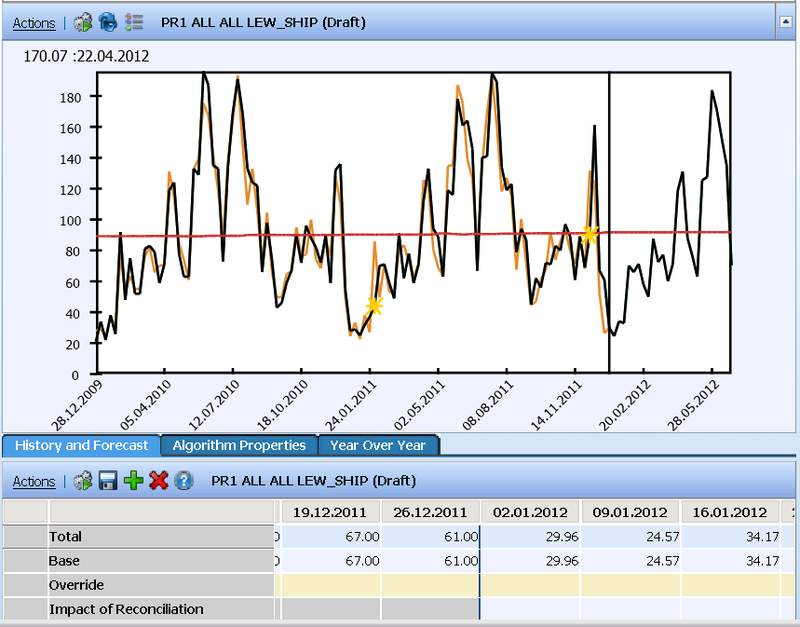
3. Then, for each product, an expert system builds a sales schedule that takes into account all possible fluctuations and factors that are driven into the system. At the user level, this is very simple: there are several basic scenarios for the sale of goods: for example, an important commodity for consumption (like bread), seasonal goods (like umbrellas), a rapidly aging product (mayfun-4), a product with a torn sales schedule (golden Maypud with diamond inlay, which is sold for 5-6 pieces per year). The product may be desirable with the launch - or gradually unwind as sales. All this can be calculated automatically or edited by hand. You can see what the system thinks about your product and evaluate how accurately the profile is selected.

4. For each product, points of atypical activity are also built: for example, if the schedule is generally flat, but there is a release somewhere, this can be either a marketing action (and then you need to show the system what it was), or a small wholesale order through a retail store or, on the contrary, the system believes that somewhere it was possible to sell more goods - and it is worth remembering if you weren’t flying out of the Yandex top at that moment, for example.

5. After such processing, all of your thousands of products get a sales profile . The system shows you which seasonal product, which one is already outdated and ready to go out of circulation, which one needs to be purchased more, and so on.

6. For goods that are sold in pairs (tablet cover, flashlight batteries, and so on) you need to build your own accounting units . In addition, if you know the related products (for example, a third of those who bought mayfun after a month purchase charging with a car adapter), interactions can also be made in the system. Automatically such things are not built yet - set up profiles - the work of the purchaser.
7. The system for each product operates with the concept of a forecasting unit DFU (Demand Forecasting Unit). Here is a very important point: DFU is not just a nomenclature unit like mayfuna, but a bunch of units and the place where it is located. For example, mayfun in Moscow may turn out to be a product of group A with a new and “hot” profile, and in Chukotka - a poorly sold product of group C, easily replaced with a regular telephone of the “brick” brand.
8. After that, the system unloads data on actual sales relative to the forecast - and the system studies by comparing the difference in forecast and real situation. At the same time, for each new forecast, the following chart is built:
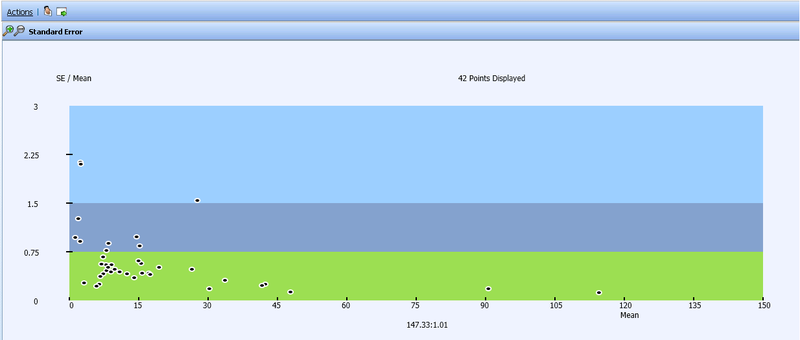
Vertically - forecast error, horizontally - the significance of the goods in circulation.
It can be divided into 4 main areas:
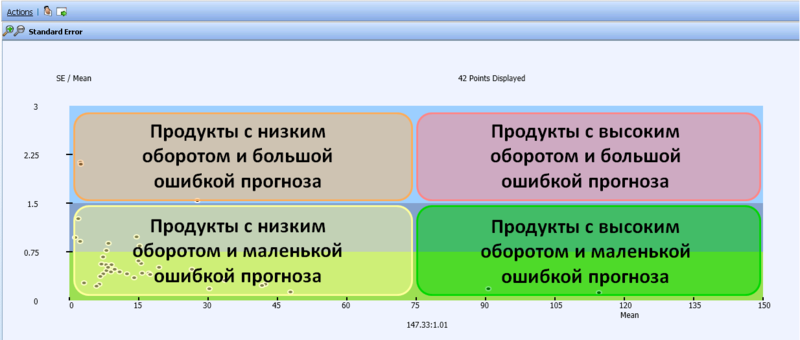
- Low turnover and low error: 70% of the goods that previously would have to be handled here will fall here. Just do not touch.
- Low turnover and high error: this is what you should do if you have time.
- High turnover and low error: you can not touch, but at least it is worth viewing.
- High turnover and high error: there are usually a few units of goods that are worth paying special attention to: there are either serious new trends, supply problems, or something else about them. In any case - just handle.
After a purchaser or a specialist in product distribution (depending on the purpose of the forecast) is full of predictions, you can build a couple of scenarios, for example, to set the situation that next month you will again sell mayfuns at a 20% discount as they did last year. The system will project these stocks last year on the forecast - and you will know how much and what to buy. What is nice, by the way, you can do promotions by brand - for example, on all covers: the system will calculate how much each of the covers needs to be bought.
9. The result is a sales forecast , which for 95% consists of automatically generated data, and 5% for data corrected by the user in accordance with the party policy and his assfing.
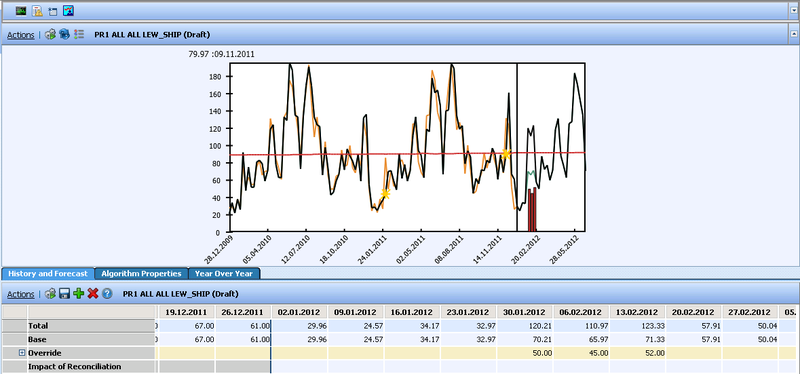
Please note: this graph can be compared with real sales for the past period: it will help you understand how accurate the forecasts are.
This forecast can be shown to management in comparison with the data of the system (here she thinks that she will sell 100 tablets with Hello Kitty, but the supplier has launched an advertisement on TV, so I think we need 120 pieces each).
So what is next?
Of course, this is cool, but if you think that, having received such a forecast, you have solved the problem, then you are in no hurry to rejoice. The thing is:
- The supplier offers you to buy instead of 500 Maypudov a container for 2000 pieces, but one and a half times cheaper. Will it be beneficial in view of warehousing? And if you also launch simultaneously a share with a discount - how then?
- The system says that you need to order 40 tablets at one of the points once a week. The problem is that they carry there at least once every two weeks, and in batches of at least a box of 200 pieces - what to do?
- The Chinese offer to deliver tablets directly to your representative office in Vladivostok - it is really more convenient and cheaper, you just need to take the container: on the one hand, great savings on delivery - on the other, it is not clear that storage, time for the tablet to become obsolete during sales and so on .
- You have already sent Russian Railways two containers of products to Yekaterinburg, and then your competitor suddenly closed and demand has greatly increased. How much should I send next time and when, taking into account these two containers?
- Your manager says that there is a suspicion that it is better to print flyers on the ground, rather than deliver it all over the country - and the lag is less, and the cost is easier. It must be considered.
- Another manager argues that sometimes it is more profitable to ship a cargo by plane than by train: although it is more expensive, it doesn’t buy goods delivered on time, which increases profits. Again need to be considered.
Previously, you handled such situations as exceptions with your hands, but with the growth of your business, they and the Russian realities are becoming more and more visible. And so you need the next piece of the system - logistics management (in the solution under consideration, this is an additional module), which can process the data of the forecasting module and make the right product at the right time at the right time. If the topic is interesting, then about it - in the next topic.
Summary
The expert demand forecasting system usually gives this (this is the benchmark of the same JDA):
- The accuracy of the forecast increases by 15-20%.
- The labor intensity of the process is seriously reduced.
- Stocks are reduced by 10-15%.
- The level of service (availability of goods) is growing by 5-10%.
- The number of errors caused by human factors decreases.
Approximately this result can be obtained if you use some kind of similar system. Above, we looked at JDA, there are other vendors that offer similar solutions: what exactly is right for your company is up to you.
For specific implementations, you can write to the following addresses:
- Alexander Efimov , Data Mining Practice Manager, Alexander.Efimov@croc.ru - if you need to understand how this can work or you want a test drive.
- Alexey Isaev , head of SCM, AlIsaev@croc.ru - if you need to calculate how much it costs and when it will be implemented, for example.
Source: https://habr.com/ru/post/161589/
All Articles